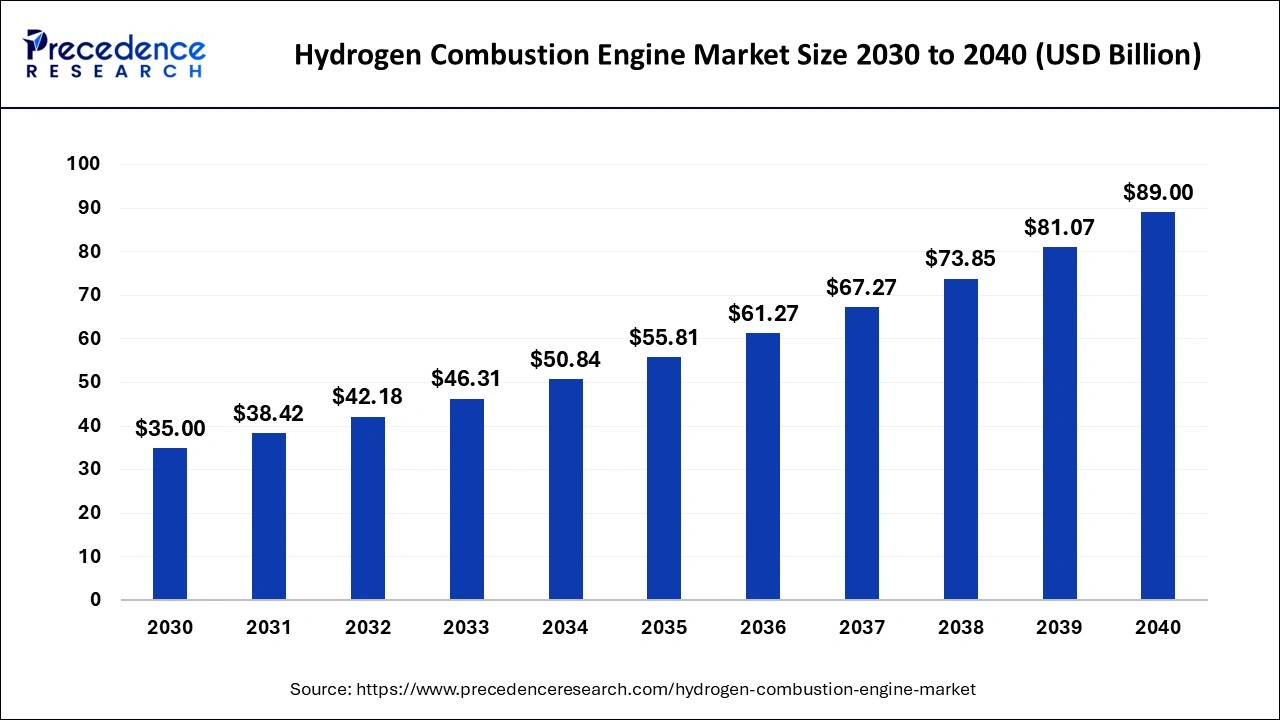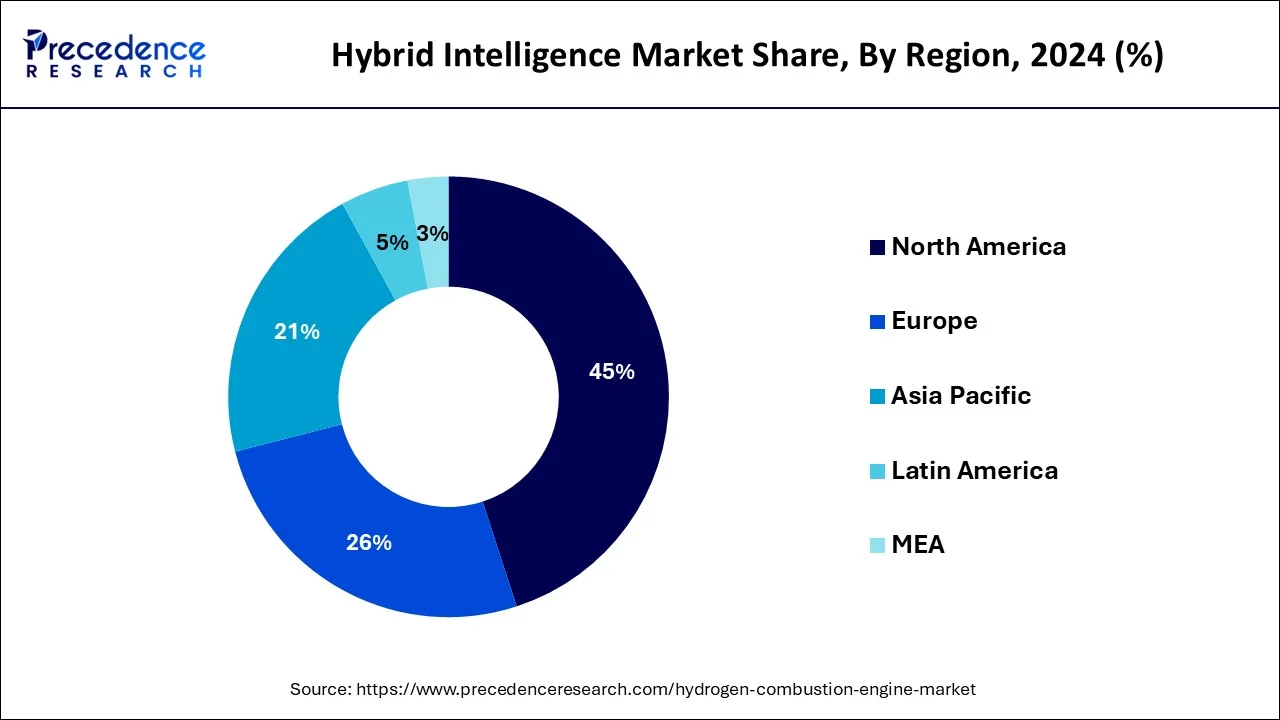January 2025
Hydrogen Combustion Engine Market (By Technology: Proton membrane exchange, Phosphoric acid fuel cell, Others; By Application: Passenger vehicle, Commercial vehicle, Ships, Others) - Global Industry Analysis, Size, Share, Growth, Trends, Regional Outlook, and Forecast 2030-2040
The global hydrogen combustion engine market size is projected to be valued at USD 35 billion in 2030 and is expected to hit around USD 89 billion by 2040 with a registered CAGR of 9.78% over the forecast period 2030 to 2040

For vehicle propulsion, hydrogen-combustion engines typically modified versions of traditional gasoline-fueled combustion engines are necessary. These engines can benefit from modern technology, providing a zero-emissions option for particular applications while promoting the expansion of hydrogen infrastructure across the world.
Alternative fuels may emerge to offer combustion engines a fresh lease on life while gasoline and diesel may be on the way out. This may portend a future when we burn hydrogen. Hydrogen has been positioned as a fuel in vehicles like the Honda Clarity and Toyota Mirai that can be used to generate energy to power what is nominally an EV. However, the fuel need not be burnt in a fuel-cell stack; it might also be done so in a combustion engine. As industrialization and global energy consumption rise, there is a daily rise in the need for fossil fuels. In order to meet the rising need for energy, several nations are searching for alternate energy sources
An alternative fuel with excellent qualities and great efficiency is hydrogen. It is anticipated that the development of hydrogen-powered vehicles would lower fuel usage and exhaust-related air pollution. The results of utilizing hydrogen as an extra fuel are looked at, along with the usage of hydrogen as a fuel in automobiles and the most recent experimental research in the literature. The implications of using hydrogen as a supplementary fuel for internal combustion gasoline, diesel, and LPG engines on engine performance and exhaust pollutants are discussed. Engine power and torque are most significantly boosted for gasoline engines depending on the amount of hydrogen injected into the fuel system, while they are diminished for diesel and LPG engines. Chemically speaking, gasoline and LPG engines emit fewer toxic exhaust gases, however, some diesel engines produce more nitrogen oxide. Furthermore, it is acknowledged that the use of hydrogen in all engine types would have a favorable impact on the environment.
The main benefits of hydrogen combustion over fossil-based fuels are the wide range of flammability and extremely high flame speed figures. With substantially greater fuel economy and very low NOx emissions, it may be effectively employed for lean burn combustion. Heavy-duty 2 L single-cylinder testing at various engine speeds and loads will be used to demonstrate the potential of lean-burn hydrogen combustion for NOx reduction.
| Report Coverage | Details |
| Market Size in 2030 | USD 35 Billion |
| Market Size by 2040 | USD 89 Billion |
| Growth Rate from 2030 to 2040 | 9.78% |
| Leading Region | North America |
| Fastest Growing Region | Asia Pacific |
| Forecast Period | 2030 to 2040 |
| By Technology | Proton Membrane Exchange, Phosphoric Acid Fuel Cell, and Others |
| By Application | Passenger Vehicle, Commercial Vehicle, Ships, and Others |
| Regions Covered | North America, Europe, Asia-Pacific, Latin America, and Middle East & Africa |
Key Market Drivers
Key Market Challenges
High costs involved in the management and generation of hydrogen
Key Market Opportunities
The primary component of the market for hydrogen combustion engines is the proton exchange membrane. The worldwide hydrogen combustion engine market is divided into proton membrane exchange and phosphoric acid fuel cells, and other technologies based on those. The proton exchange membrane, which transports protons from the anode to the cathode across the membrane, is crucial to the successful completion of the electrochemical process. In a hydrogen engine, oxygen is reduced at the cathode, and hydrogen is delivered, which is then oxidized at the anode. The segment's adoption is predicted to rise fast over the projection period, supporting this expectation. Additionally, liquid phosphoric acid is utilized as the electrolyte present in the phosphoric acid fuel cells, or also known as PAFC. Due to its reliability, effectiveness, and affordability, this is frequently used and has fueled the market's expansion throughout the foreseeable future.
Commercial vehicles are four-wheeled conveyances used for goods transportation. Commercial vehicles on the road are those that transport people, goods, or both. This group of vehicles includes buses, trucks, vans, and others that are comparable. Every economy needs commercial vehicles as they are necessary for the mobility of both people as well as products.
A road vehicle, like a car, van, or truck, that is primarily used to transport people rather than cargo is known as a passenger vehicle. Manufacturers of passenger cars have developed a market niche for appealing to the country's middle class with affordable costs, high-quality features, compact sizes, and straightforward financing choices. For instance, according to the International Organization of Motor Vehicle Manufacturers, worldwide automobile manufacturing fell by 16% to fewer than 78 million cars or sales levels from 2010. (OICA).
According to geography, North America is anticipated to have a significant market share for hydrogen combustion engines throughout the anticipated time frame. This is due to the rising R&D expenditures made to create cutting-edge solutions and meet end-user demands. Additionally, the U.S. government's programs for ecological sources are promoting market expansion throughout the area. Although the hydrogen combustion engine is still in its infancy, policymakers are being prompted to support the use of hydrogen internal combustion engines by the negative effects of CO2 emissions in industrialized and rising countries, like the United States and China. The government in Europe has requested manufacturers to reduce CO2 emissions for new on-highway vehicles by about 30% starting in 2030. Similar objectives for reducing emissions have been set by the United States and China. As a result, the domestic market participants in the relevant regions are seeing prospects for expansion.

During the projected period, the hydrogen combustion engine market is anticipated to exhibit the greatest CAGR in Asia-Pacific. This is supported by the region's key market players' expansion and rising fuel prices, which will drive market development in the ensuing years.
Segment Covered in the Report
By Technology
By Application
By Geography
For inquiries regarding discounts, bulk purchases, or customization requests, please contact us at sales@precedenceresearch.com
No cookie-cutter, only authentic analysis – take the 1st step to become a Precedence Research client
January 2025
December 2024
January 2025
January 2025